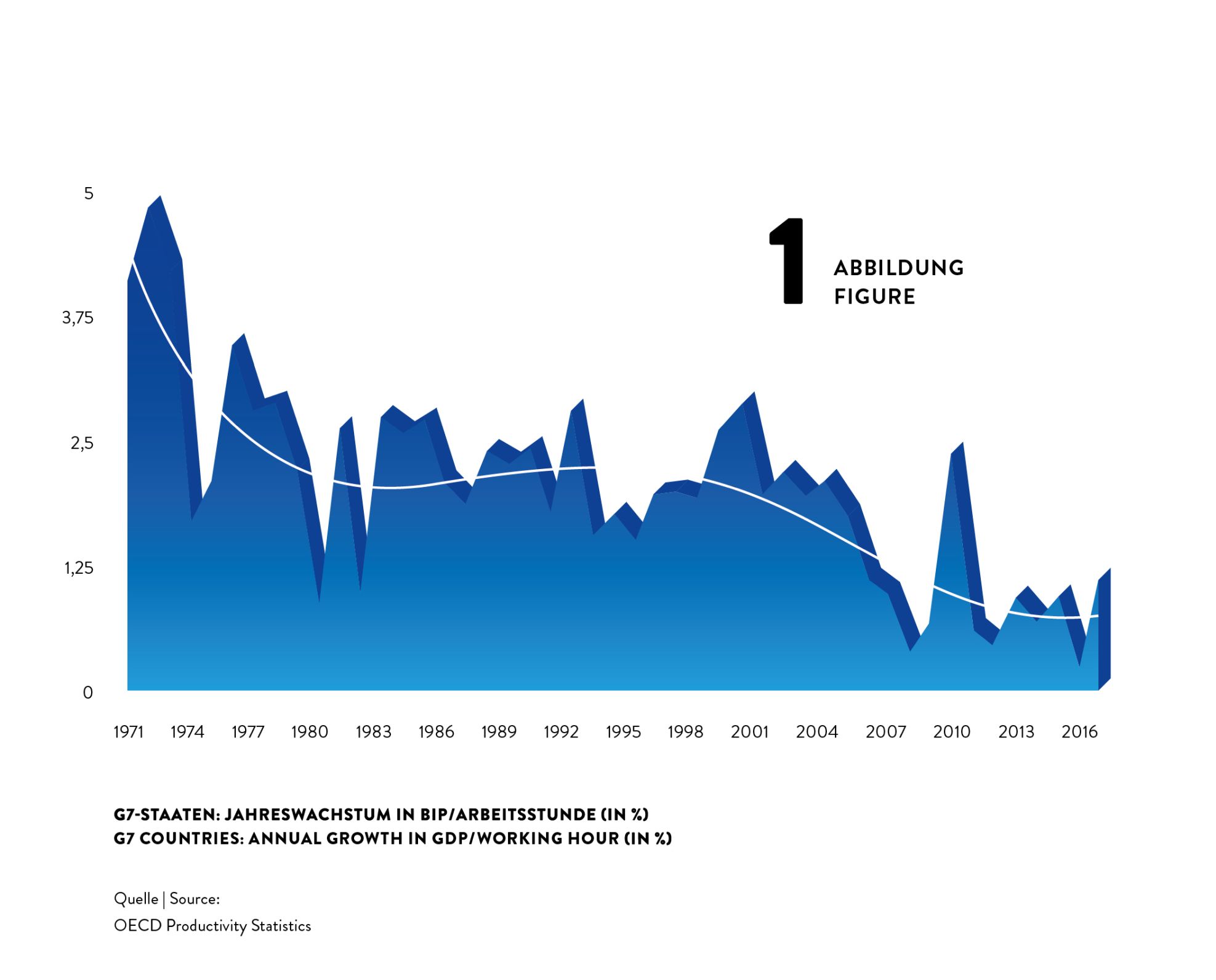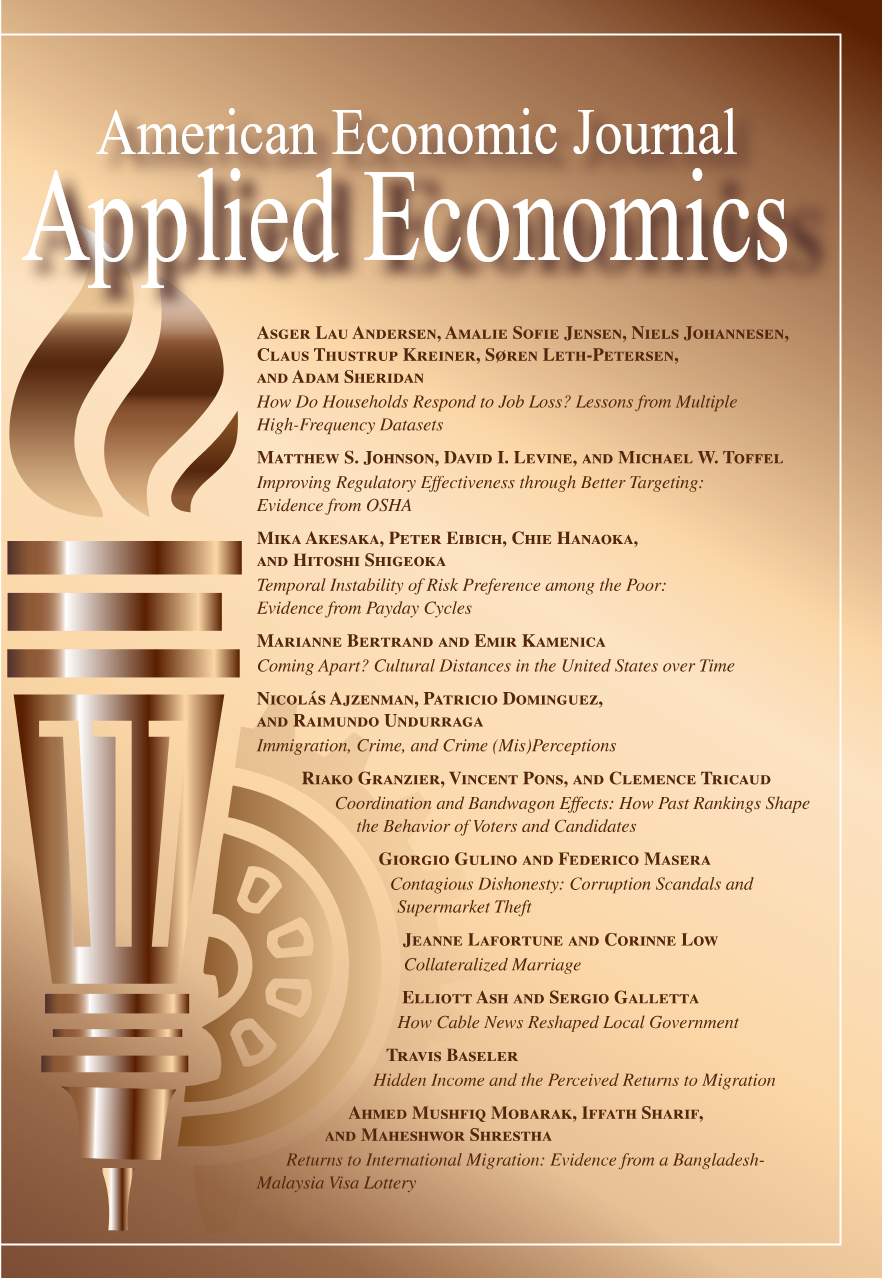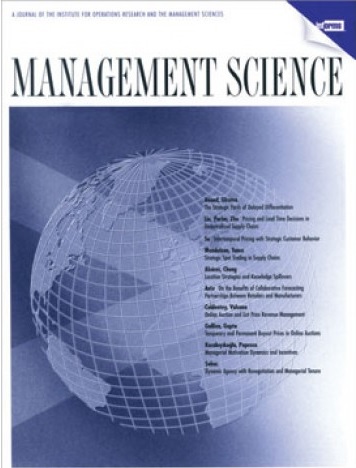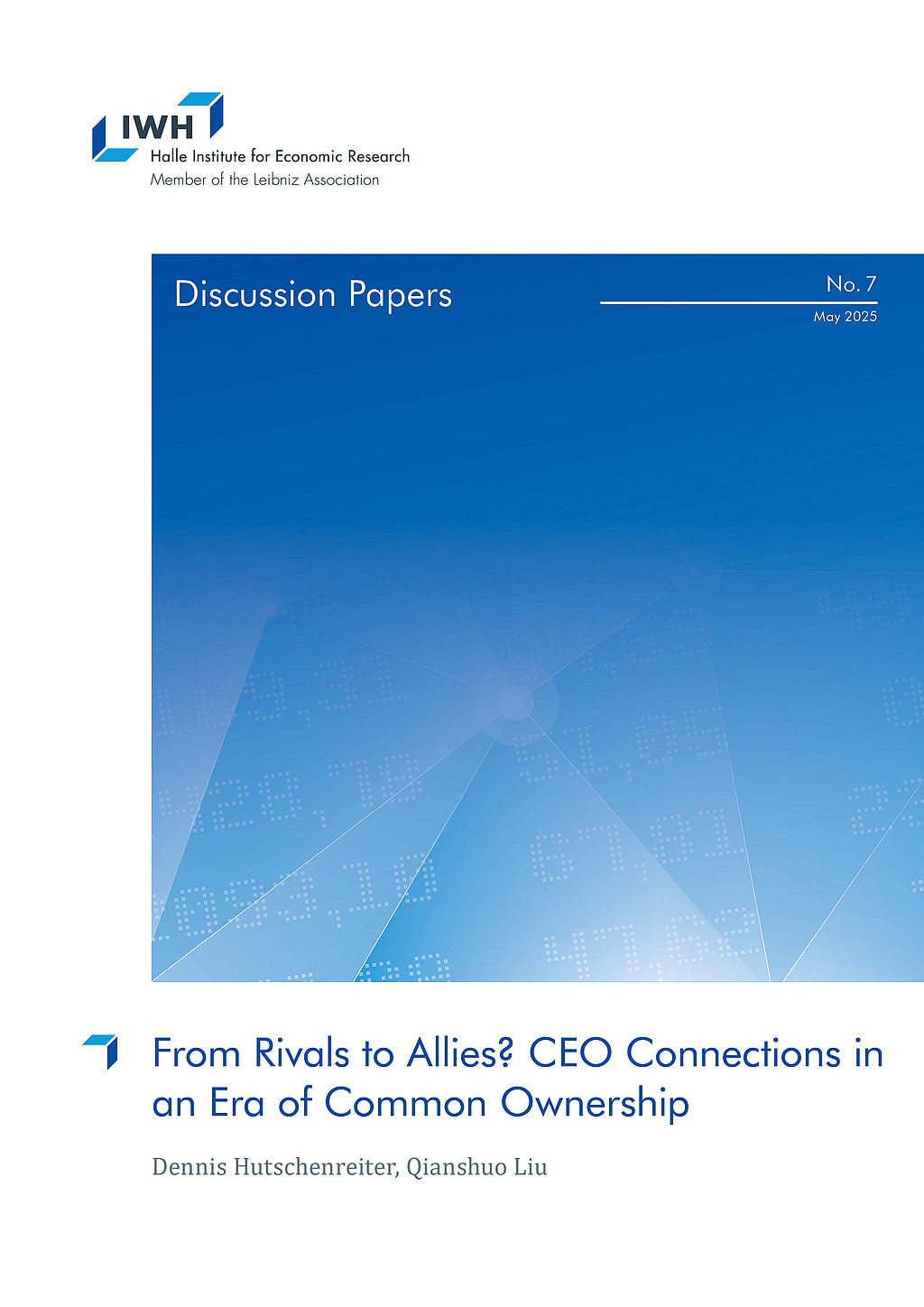Productivity: More with Less by Better
Available resources are scarce. To sustain our society's income and living standards in a world with ecological and demographic change, we need to make smarter use of them.
Dossier

In a nutshell
Nobel Prize winners Paul Samuelson and William Nordhaus state in their classic economics textbook: Economics matters because resources are scarce. Indeed, productivity research is at the very heart of economics as it describes the efficiency with which these scarce resources are transformed into goods and services and, hence, into social wealth. If the consumption of resources is to be reduced, e. g., due to ecological reasons, our society’s present material living standards can only be maintained by productivity growth. The aging of our society and the induced scarcity of labour is a major future challenge. Without productivity growth a solution is hard to imagine. To understand the processes triggering productivity growth, a look at micro data on the level of individual firms or establishments is indispensable.
Our experts

Department Head
If you have any further questions please contact me.
+49 345 7753-708 Request per E-Mail
President
If you have any further questions please contact me.
+49 345 7753-700 Request per E-MailAll experts, press releases, publications and events on “Productivity”
Productivity is output in relation to input. While the concept of total factor productivity describes how efficiently labour, machinery, and all combined inputs are used, labour productivity describes value added (Gross Domestic Product, GDP) per worker and measures, in a macroeconomic sense, income per worker.
Productivity Growth on the Slowdown
Surprisingly, despite of massive use of technology and rushing digitisation, advances in productivity have been slowing down during the last decades. Labour productivity growth used to be much higher in the 1960s and 1970s than it is now. For the G7 countries, for example, annual growth rates of GDP per hour worked declined from about 4% in the early 1970s to about 2% in the 1980s and 1990s and then even fell to about 1% after 2010 (see figure 1).

This implies a dramatic loss in potential income: Would the 4% productivity growth have been sustained over the four and a half decades from 1972 to 2017, G7 countries’ GDP per hour would now be unimaginable 2.5 times as high as it actually is. What a potential to, for instance, reduce poverty or to fund research on fundamentals topics as curing cancer or using fusion power!
So why has productivity growth declined dramatically although at the same time we see, for instance, a boom in new digital technologies that can be expected to increase productivity growth? For sure, part of the decline might be spurious and caused by mismeasurement of the contributions of digital technologies. For instance, it is inherently difficult to measure the value of a google search or another video on youtube. That being said, most observers agree that part of the slowdown is real.
Techno-Pessimists and Techno-Optimists
Techno-pessimists say, well, these new technologies are just not as consequential for productivity as, for instance, electrification or combustion engines have been. Techno-optimists argue that it can take many years until productivity effects of new technologies kick in, and it can come in multiple waves. New technology we have now may just be the tools to invent even more consequential innovations in the future.
While this strand of the discussion is concerned with the type of technology invented, others see the problem in that inventions nowadays may diffuse slowly from technological leaders to laggards creating a wedge between few superstar firms and the crowd (Akcigit et al., 2021). Increased market concentration and market power by superstar firms may reduce competitive pressure and the incentives to innovate.
Finally, reduced Schumpeterian business dynamism, i.e. a reduction in firm entry and exit as well as firm growth and decline, reflects a slowdown in the speed with which production factors are recombined to find their most productive match.
While the explanation for and the way out of the productivity puzzle are still unknown, it seems understood that using granular firm level data is the most promising path to find answers.
What are the Origins of Productivity Growth?
Aggregate productivity growth can originate from (i) a more efficient use of available inputs at the firm level as described above or (ii) from an improved allocation of resources between firms.
Higher efficiency at the firm level captures, e.g., the impact of innovations (Acemoglu et al., 2018) or improved firm organisation (management) (Heinz et al., 2020; Müller und Stegmaier, 2017), while improved factor allocation describes the degree of which scarce input factors are re-allocated from inefficient to efficient firms (‘Schumpeterian creative destruction’) (Aghion et al., 2015; Decker et al., 2021).
Most economic processes influence the productivity of existing firms and the growth and the use of resources of these firms and their competitors as well. The accelerated implementation of robotics in German plants (Deng et al., 2020), the foreign trade shocks induced by the rise of the Chinese economy (Bräuer et al., 2019), but also the COVID-19 pandemic, whose consequences are still to evaluate (Müller, 2021) not only effects on productivity and growth of the firms directly affected but at the same time may create new businesses and question existing firms.
While productivity can be measured at the level of aggregated sectors or economies, micro data on the level of individual firms or establishments are indispensable to study firm organisation, technology and innovation diffusion, superstar firms, market power, factor allocation and Schumpeterian business dynamism. The IWH adopts this micro approach within the EU Horizon 2020 project MICROPROD as well as with the CompNet research network.
As “creative destruction” may also negatively affect the persons involved (e. g., in the case of layoffs, Fackler et al., 2021), the IWH analyses the consequences of bankruptcies in its Bankruptcy Research Unit and looks at the implications of creative destruction for the society, e. g., within a project funded by Volkswagen Foundation searching for the economic origins of populism and in the framework of the Institute for Research on Social Cohesion.
Publications on “Productivity”

Voice at Work
in: American Economic Journal: Applied Economics, forthcoming
Abstract
<p>We estimate the effects of worker voice on productivity, job quality, and separations. We study the 1991 introduction of a right to worker representation on boards or advisory councils in Finnish firms with at least 150 employees, designed primarily to facilitate workforce-management communication. Consistent with information sharing theories, our difference-in-differences design reveals that worker voice slightly raised labor productivity, firm survival, and capital intensity. In contrast to the exit-voice theory, we find no effects on voluntary job separations, and at most small positive effects on other measures of job quality. A 2008 introduction of shop-floor representation had similarly limited effects.</p>

The (Heterogeneous) Economic Effects of Private Equity Buyouts
in: Management Science, forthcoming
Abstract
<p>The effects of private equity buyouts on employment, productivity, and job reallocation vary tremendously with macroeconomic and credit conditions, across private equity groups, and by type of buyout. We reach this conclusion by examining the most extensive database of U.S. buyouts ever compiled, encompassing thousands of buyout targets from 1980 to 2013 and millions of control firms. Employment shrinks 12% over two years after buyouts of publicly listed firms—on average, and relative to control firms—but expands 15% after buyouts of privately held firms. Postbuyout productivity gains at target firms are large on average and much larger yet for deals executed amid tight credit conditions. A postbuyout tightening of credit conditions or slowing of gross domestic product growth curtails employment growth and intrafirm job reallocation at target firms. We also show that buyout effects differ across the private equity groups that sponsor buyouts, and these differences persist over time at the group level. Rapid upscaling in deal flow at the group level brings lower employment growth at target firms. We relate these findings to theories of private equity that highlight agency problems at portfolio firms and within the private equity industry itself.</p>

Who is Using Robots in Germany?
in: IFR International Federation of Robotics, Member blog - Jul 09 2025
Abstract
<p>IFR statistics show that Germany has consistently been a global top 5 robotics market for many years. They also provide distribution by industry. But what it does not show is who exactly is installing these robots and what distinguishes a robot user from a non-user. Data collected from nearly 16,000 plants by the Institute for Employment Research (IAB) of the Federal Employment Agency helps us to learn more about robot users in Germany.</p>

From Rivals to Allies? CEO Connections in an Era of Common Ownership
in: IWH Discussion Papers, No. 7, 2025
Abstract
<p>Institutional common ownership of firm pairs in the same industry increases the likelihood of a preexisting social connection among their CEOs. We establish this relationship using a quasi-natural experiment that exploits institutional mergers combined with firms’ hiring events and detailed information on CEO biographies. In addition, for peer firms, gaining a CEO connection from a hiring firm’s CEO appointment correlates with higher returns on assets, stock market returns, and decreasing product similarity between companies. We find evidence consistent with common owners allocating CEO connections to shape managerial decisionmaking and increase portfolio firms’ performance.</p>

Robot Hubs and the Use of Robotics in US Manufacturing Establishments
in: American Economic Association Papers and Proceedings, May 2025
Abstract
<p>We use data from the Annual Survey of Manufactures to study the characteristics and geographic distribution of investments in robots across US manufacturing establishments. Robotics adoption and robot intensity (the number of robots per employee) cluster in "robot hubs." Establishments that report having robotics are larger and have a larger production worker share, lower pay per worker, lower labor share, and higher capital expenditures, including higher IT capital expenditures. Notably, establishments are more likely to have robots if other establishments in the same core-based statistical area and industry also report having robotics, suggestive of agglomeration and peer effects.</p>



